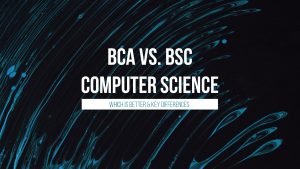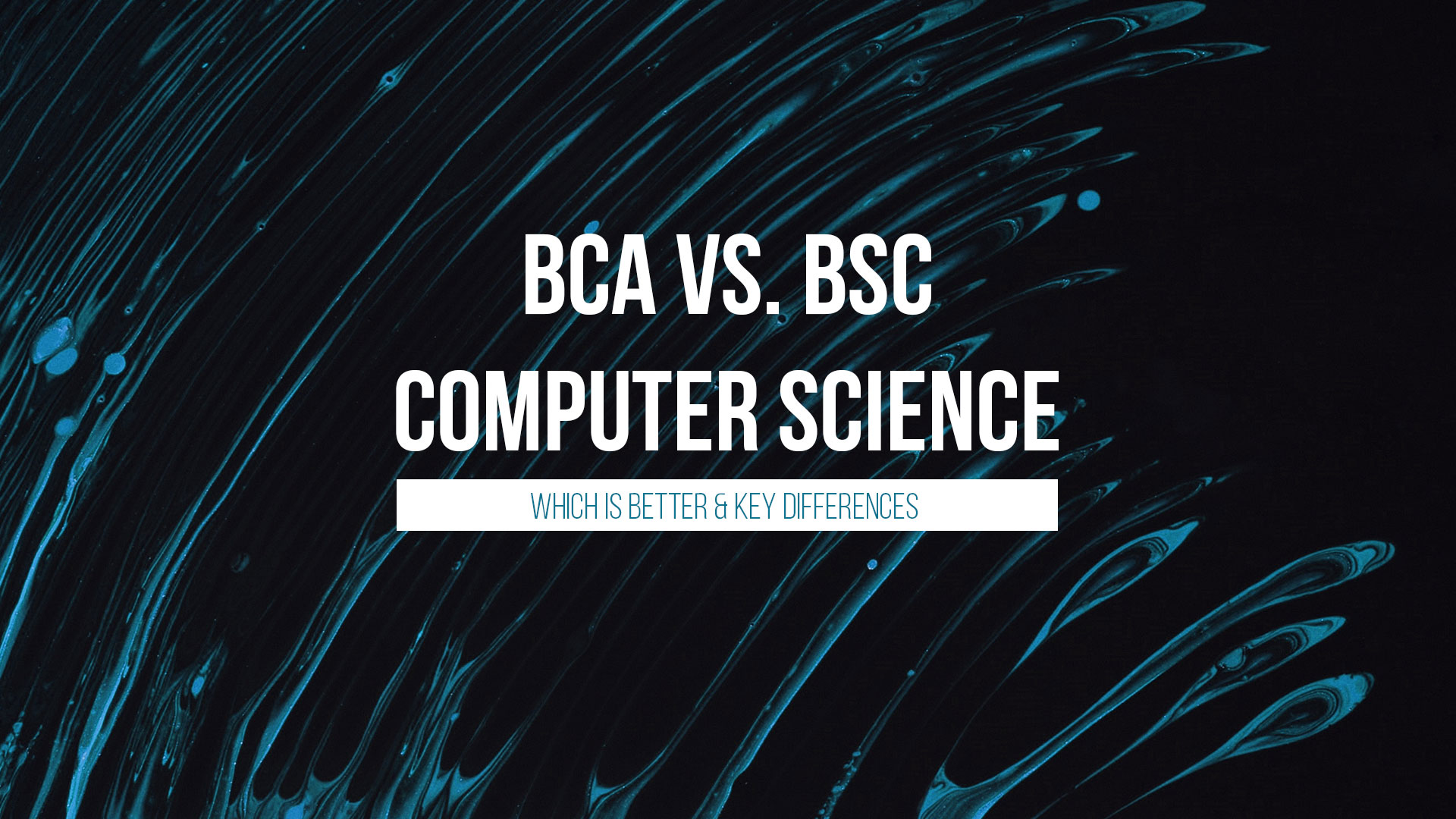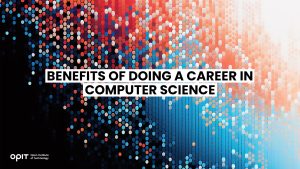

Do you tend to get all technical about how computers work? Or, do you prefer to put your thinking cap on and dig deep into theory and research?
These questions matter because they can help you choose between BCA and BSc Computer Science. One focuses on practical knowledge, while the other explores the nitty-gritty behind technical concepts.
In this BCA vs. BSc computer science: which is better guide, we’ll provide detailed information about the two courses and help point you in the right direction.
BCA: Bachelor of Computer Applications
To resolve the BSc computer science vs. BCA confusion, we need to discuss both in detail. Let’s start with BCA: Bachelor of Computer Applications.
Overview of the BCA Program
Duration
BCA is typically a three-year professional undergraduate course focused on learning computer languages and applications. Since the focus is on applications, the BCA program is a software-oriented course (which is great for those who don’t enjoy learning too much theory).
Course Structure
The course structure depends on your chosen university. In most cases, you’ll have five core subjects per semester. Additionally, you’ll choose electives to learn more about specific computer-related topics.
Eligibility Criteria
Every university is free to set its own criteria for enrolling in a BCA program. Still, there are some tendencies you should know about. Students who studied arts, commerce, or science are most welcome to apply. Some universities may also have specific entrance exams that test subject-related knowledge.
Key Subjects Covered in BCA
As mentioned, the course structure in BCA programs varies (depending on the university). Regardless, every student needs to cover core subjects that will equip them to conquer the industry.
Programming Languages
Programming languages are like human languages. But rather than allowing communication among people, these languages let us “talk to” computers. This subject covers the basics of Java, HTML, C, C++, and others.
Database Management
Think of database management systems as computerized data-keeping solutions. Learning how to work with these systems is essential to ensure proper information storage and retrieval, and this is exactly what students learn on this course.
Web Development
Want to know how to create and maintain websites? This subject offers insight into behind-the-scenes work that goes into developing online stores, social networks, blogs, business websites, and others.
Networking
This subject explores the secret language in which computers, systems, and devices communicate with one another. All of which sheds light on how to connect them to share data.
Career Prospects After BCA
A degree in computer application opens doors to various career paths. Here are the job positions you can apply for after completing your studies:
- Game Designer
- System Specialist
- Technical Support
- Web Designer
- Network Administrator
- System Manager
- Software Tester
- Programmer
In terms of continuing your education, these options are available:
- Master in Computer Application
- Master of Science in Information Technology
- Master in Business Administration
BSc Computer Science: Bachelor of Science in Computer Science
If you want to know which is better: BCA or BSc Computer Science, you need to learn more about them. Since we’ve covered the BCA program, it’s time to discuss BSc Computer Science.
Overview of the BSc Computer Science Program
Duration
Students can choose between two options: regular and fast-track. The former lasts three years, while the latter lasts two.
Course Structure
One of the first things students are interested in is the course structure. In most cases, you’ll have six terms – five terms of courses and one for the final project (dissertation).
That being said, remember that every university sets its own course structure.
Eligibility Criteria
Universities set their eligibility criteria. Therefore, each institution has unique standards students have to meet to enroll. Some universities have strict requirements, the most common being a background in physics, chemistry, or mathematics.
If you don’t meet these criteria, no worries. Online degree programs like the Open Institute of Technology (Opit) have easy-to-meet entry requirements, such as English proficiency (at least a B2 level) and high school education.
Key Subjects Covered in BSc Computer Science
The BSc Computer Science program features several core subjects.
Programming Languages
During this course, students learn how to “speak” programming languages. They’re introduced to fundamental concepts and common logical and/or syntactical problems they need to resolve.
Data Structures and Algorithms
If you want to learn how to organize data or solve a particular problem, you’ll find the answers to these questions and more in this course.
Operating Systems
Every OS is an entity of its own with unique anatomies, functions, and layers.
Computer Networks
A computer network is a cluster of interconnected dots that communicate with each other and transfer data. During this course, you’ll learn how this communication works.
Career Prospects After BSc Computer Science
What can you do after BSc Computer Science? The program allows you to explore a wide array of job positions:
- Software Developer/Engineer
- Web Developer
- Data Scientist
- Cyber Security Analyst
- Database Architect
- IT Business Analyst
- App/Game Developer
- Database Architect
BSc Computer Science offers an excellent theoretical foundation. It’s no surprise, therefore, that many students decide to pursue higher education. Here are some of the available options:
- Master of Science in Computer Science
- Master in Computer Management
- Bachelor of Technology in Computer Science
Key Differences Between BCA and BCs Computer Science
Want to know which is better: BSc Computer Science or BCA? To get the answer, you need to learn about the differences between the two degrees.
Course Focus
You wouldn’t be wrong if you said the two programs are similar. But there’s a significant difference between BCA and BSc Computer Science: course focus. BCA is all about application it centers on current technology, computing, and programming trends. The program is ideal for students who are more interested in practical knowledge.
On the other hand, BSc Computer Science is perfect for those who like reading theory, doing research, and learning about different computer-related concepts.
Curriculum
The battle between theoretical and practical knowledge is (of course) reflected in the curriculum. The subjects BCA features develop practical, application-oriented skills, while BSc Computer Science prefers theory.
Eligibility Criteria
While trying not to sound like a broken record, let’s repeat it once again: it depends on the university. As a rule of thumb, BSc Computer Science has stricter criteria.
Career Opportunities
As far as career opportunities are concerned, both programs will set you up for success in the industry. Of course, each program opens doors to different fields. Students who complete the BCA program pursue jobs in IT or software development. Those who complete the BSc Computer Science program usually continue their education or work as researchers.
Which Is Better: BCA or BSc Computer Science?
Given that each program focuses on different aspects, it’s hard to say one stands out as “the best.” Every person is unique, and what suits you may not work for someone else. It all comes down to your future plans and ambitions. Going down the technical-heavy route is great for coding or anything else that calls for theoretical applications, but it won’t help much if you need experience in something practical, like game design. By the same token, you’ll need to draw from a well of technical knowledge when you’re working in data science or IT analysis. The choice comes down to balancing these three factors:
- Personal interest and aptitude – Do you prefer theory or practice?
- Career goals – What do you want to do after completing the program?
- Future education plans – Do you want to continue your education after the program?
Answer these questions to get a better idea of whether you should opt for BCA or BSc Computer Science. Remember, there’s no wrong answer. Picking a course isn’t like playing Russian roulette. It’s more like playing those little arcade machines that guarantee a prize with every turn – there’s no way to lose! Whatever you choose, you can build a fruitful career with computers. The path you decide to take solely depends on whether you prefer theory or practice.
Pros and Cons of Each Course
What are the strengths and weaknesses of each course? Find out here.
BCA
Pros:
- Offers practical knowledge
- Follow the latest industry trends
- Less strict entry requirements
- Job-oriented
Cons:
- Challenging course structure
- Technology rapidly evolves, so you need to constantly update your skills to stay current
BCs in Computer Science
Pros:
- Offers excellent theoretical knowledge
- Great for those who want to continue their education
- Ideal for researchers
- Provides a strong foundation
Cons:
- Stricter eligibility criteria
- Some consider it too theoretical
Tips for Making the Right Choice
These valuable tips can help you choose the right program:
- Consider your expectations. Think about what you want to get from this course and where you want it to take you career-wise.
- Study the curriculum. The curriculum is like a program’s CV. If you want to know whether it’s a good fit for you, you need to research it carefully.
- Talk to someone who completed the program you’re interested in. A person who completed the course can offer valuable intel and help you determine whether you’re on the right track.
- Consult an academic advisor. An advisor can analyze your preferences and put them into a concrete suggestion on which direction you should take.
- Think about what you want to do next. Do you want to continue your education or find a job in the industry? The answer can help you make the right decision.
Find Your Passion
The biggest difference between BSc Computer Science and BCA lies in the curriculum. With the former, the subjects focus on obtaining theoretical knowledge to set the ground for further education or research. On the other hand, BCA focuses on practical skills and exploring current trends.
Instead of wondering which is best: BCA or BSc Computer Science, think about your preferences and requirements. Explore your priorities, research both options, talk to professionals, and you’ll recognize the better fit.
Related posts

Life is unpredictable. While many of us have specific hopes and expectations of how our futures will turn out, things don’t always go as expected. There are many variables and unexpected incidents that can interfere and force you to alter your plans, and this is particularly true when it comes to education.
For instance, you might have had plans to study a specific subject, but had to deviate from those plans due to unforeseen circumstances. Or you may have had to enter the workforce in an occupation different from the one you sought in an effort to earn an income, a move that may not provide you with the time or opportunity to achieve your desired educational aims.
In short, every individual’s career pathway is different, and very few go exactly as we expect from the outset. Fortunately, even if you experience a few false starts or sudden twists in your pathway, there are always options available to help you get back on track.
The Unpredictable Nature of Education
In theory, the educational process seems simple. You select a course of study that interests you from the vast array of subjects and prospective professions, select the appropriate classes, acquire the knowledge and skills you need to succeed, and then embark on your profession.
In reality, however, as many people know from firsthand experience, the road to education is often far from straightforward. Here are just some of the many challenges that can take your educational path in a completely different direction:
- Life’s Curveballs: As touched on in the introduction, life is impossible to predict. Financial hardships, health issues, and family emergencies are just some of the unfortunate occurrences that might derail even the most perfectly planned educational regime.
- Changing Interests: People’s desires and preferences don’t necessarily stay the same throughout their entire lives. As you grow, learn, and have new experiences, your interests may change, and so, too, may your educational objectives.
- Pressure and Burnout: Some academic paths are particularly challenging, demanding intense levels of study and hard work. This can sometimes prove too much to bear, even for the most resilient students.
- Failures and Setbacks: Conventional education largely builds around tests and examinations, requiring students to demonstrate their competencies repeatedly. It’s a system that doesn’t suit everyone, and test failures can lead to setbacks and delays.
- Inequality: People can be born with very different privileges and levels of access to education. Those in certain parts of the world may find it much more challenging to complete their education path for financial, cultural, or even political reasons.
- Late Bloomers: People develop at different paces. Some may struggle educationally early on in their lives, forcing them to make certain concessions or sacrifices related to their studies, only to find their feet later in life once they’ve entered the world of work.
Whether you’re a late bloomer, have had your educational aspirations delayed by personal problems, desire to learn new skills and try something different, or want to begin a fresh chapter in your professional life, the Open Institute of Technology (OPIT) may be able to help.
Introducing OPIT
OPIT is an online teaching platform, making high-level technological educational programs accessible to all, no matter their age or background. Offering education in fields like computer science, artificial intelligence, and digital business, OPIT provides a curated collection of degrees. In addition, they offer classes taught by world-leading tutors imparting the wisdom and skills students need to achieve their goals and become the tech leaders of tomorrow.
Meanwhile, for those who have had somewhat tumultuous or unpredictable educational paths, OPIT offers the perfect course corrector: the OPIT Foundation Year.
The OPIT Foundation Year
OPIT’s Foundation Year is a Pre-Tertiary Certificate in Information Technology, fully aligned with MQF/EQF Level 4 standards and valued at 60 ECTS credits. Lasting just one year, this program essentially serves as a comprehensive yet accessible springboard towards higher-level education, creating a path towards degrees and careers in dynamic, flexible fields, like computer science and digital business.
Like other OPIT programs, the Foundation Year is delivered entirely online via the OPIT Virtual Learning Environment. Combining live lectures, asynchronous content, and interactive assessments, students enjoy diverse and dynamic study experiences, acquiring core skills like academic writing, mathematics, and computer literacy, and building a bedrock of knowledge and confidence before taking their next steps.
Who Is the Foundation Program For?
The Foundation Program is designed to provide a solid base upon which to build the technological education many students need. It’s the perfect choice for those who are eager and ambitious to enter professions in AI, data science, and computing, but don’t feel that they have the necessary core skills and knowledge needed to dive straight into a degree.
Entry requirements are relatively relaxed in order to allow as many students as possible to enjoy the benefits of this program. With that said, applicants should ideally hold an MQF/EQF Level 3 or equivalent qualification, with the intention of pursuing a bachelor’s degree. A minimum of B2 level of English proficiency is also required, as this is the working and studying language of the institution.
What the Foundation Year Provides
Perhaps you’ve recently graduated, are considering a career change, or finally have the opportunity to return to education after initial delays or unexpected disruptions to your original plans. Either way, the Foundation Year can help you enjoy:
- Greater Self-Confidence: Foundation Year graduates gain the fundamental skills they need to enter degree programs with much more self-belief and assuredness.
- Superior Tech Knowledge: Lasting two terms, this course explores mathematics, academic reading and writing, and provides an introduction to computer hardware and software.
- Foundational Mathematics: Mathematics literacy forms a large part of the study focus for the Foundation Year, helping students feel more comfortable with numbers and formulas.
- Flexible Learning: Unlike more rigid, conventional education environments, OPIT gives you the freedom and flexibility to study at a pace that suits you best, all from the comfort of home.
- Global Community: OPIT is an international institution, with staff and students from all around the world eager to share knowledge, exchange ideas, and help one another.
Take Your Next Steps to Success With the OPIT Foundation Year
If you’re curious about a career in technology or have always wanted to work with AI, data, and computers, but struggled to find the time and opportunities you need to acquire relevant skills and knowledge, the Foundation Program was made for people like you.
It’s the ideal entry point into the exciting world of online education, and the perfect first step towards a prestigious degree from an innovative and increasingly successful institution. Download the brochure to learn more about it, or start your online application, today.

Students today have a broader range of fields of study to choose from than ever before, but with the world becoming increasingly technological and computers increasing in influence and importance, pursuing a career in computer science often proves a smart, strategic choice.
There are numerous benefits and career paths associated with studying and working in computer science, and we’ll be listing just a few of them in this guide.
High Average Salaries
With the rising cost of living in many parts of the world, it’s unsurprising that many students are thinking several decades ahead to determine what level of starting salaries they could obtain in different career fields.
Many are also seeking professions that offer the opportunity for growth and the ability to advance up the ranks over time, thus increasing their salary and their quality of life in the process.
If a strong, stable salary with the opportunity for improved income is one of your top career priorities, computer science should be at or near the top of your list of prospective careers.
According to recent data, computer scientists earn an average of over €65,000 per year, with certain jobs, like IT project leader and data scientist, paying ever higher. Starting salaries are strong, too, with graduates earning anywhere from €46,000 to €60,000, depending on their chosen profession and level of qualifications.
There are similarly high average salaries reported around the world in computer science and related fields such as data science and AI/ML engineering. These numbers are projected to increase in the years to come, pointing to computer science as a way for graduates to get off to the best financial start of any career.
Unrivaled Flexibility
A common problem with some subjects and courses is that they only provide graduates with a narrow set of skills and a similarly narrow range of potential professions to which they can apply those skills.
That’s not the case with computer science. Graduates in this field can enjoy instant access to a remarkably diverse array of career opportunities, with even newer opportunities being created all the time as technology evolves and innovations emerge.
A few of the many industries and roles you might choose to enter in the field of computer science include:
- Healthcare: As a software developer, data analyst, or cybersecurity expert
- Finance: As a fintech engineer, blockchain developer, or security analyst
- Media: As a graphics programmer, AI developer, or game developer
- Education: As an analyst, software developer, or machine learning engineer
Guaranteed Opportunities
Some career paths are more limited than others, with relatively low numbers of opportunities, recurring risks of job loss, or difficulty obtaining employment in the first place.
Again, with computer science, this simply isn’t the case. At a time when 75% of companies plan to embrace AI and other technologies by 2027, and businesses of all sizes and industries are now relying on computers more than ever before, computer science graduates can enjoy almost unbeatable job security.
Opportunities will continue to grow for people with good computing knowledge, whether that be in the obvious fields like software and web development, engineering, and AI development, or more niche sectors.
With so many options, you’re effectively guaranteed a long, rewarding career if you put in the necessary time and effort needed to establish a strong foundation of computing skills.
Rapidly Expanding and Evolving Industries
It’s no secret that the world of technology is a dynamic and fast-moving one. In the past 20 years alone, we’ve seen the proliferation of the internet, the rapid advancement of smartphones and wearable devices, the emergence of AI, and so much more.
In the years ahead, engineers and developers will continue to explore the boundaries of modern technology’s powers and potential, driving new innovations and improvements and opening more exciting job opportunities for those already established and experienced in this field.
Getting into computer science now could therefore provide a solid foundation for a career filled with excitement as you uncover and explore new ways of working with computers in fields as diverse as healthcare, finance, education, entertainment, manufacturing, logistics, and beyond.
Start Your Computer Science Career at OPIT
We’ve discussed some of the many benefits associated with careers in computer science, from the high starting salaries to the rapidly growing array of job options available to graduates. By now, you may be eager to follow this particular career path and take advantage of the wealth of opportunities.
If you’re wondering how to start, the Open Institute of Technology (OPIT) may hold the answers you need. As an exclusively online learning platform, specializing in computer science and digital business, and staffed by some of the world’s leading tech experts, OPIT is producing the tech leaders of tomorrow.
Some of the many advantages of learning with OPIT include:
- Accessible and flexible online education that matches your learning style and schedule
- Heavy focus on real-world applications of the skills you acquire
- An international community of like-minded students from around the globe
- A top team of tutors and lecturers from varying fields and industries
- Progressive assessment of skills and understanding – not constant exams
OPIT offers a small, curated selection of courses for those seeking to gain the technological skills and knowledge to succeed in their chosen areas of expertise. That includes a BSc (Hons) in Computer Science – a six-term program, worth 180 ECTS credits.
Numerous IT industry leaders and experts helped develop this fully accredited undergraduate degree, which is online and accessible to all. Like other OPIT courses, it offers a flexible learning program, with progressive assessments, fast-track options, and the opportunity to be part of a growing community of learners and tutors.
If the benefits of doing a career in computer science interest you, download the OPIT BSc in Computer Science brochure or fill out an online application today and take your first step toward a rewarding and fulfilling profession.
Have questions?
Visit our FAQ page or get in touch with us!
Write us at +39 335 576 0263
Get in touch at hello@opit.com
Talk to one of our Study Advisors
We are international
We can speak in:


